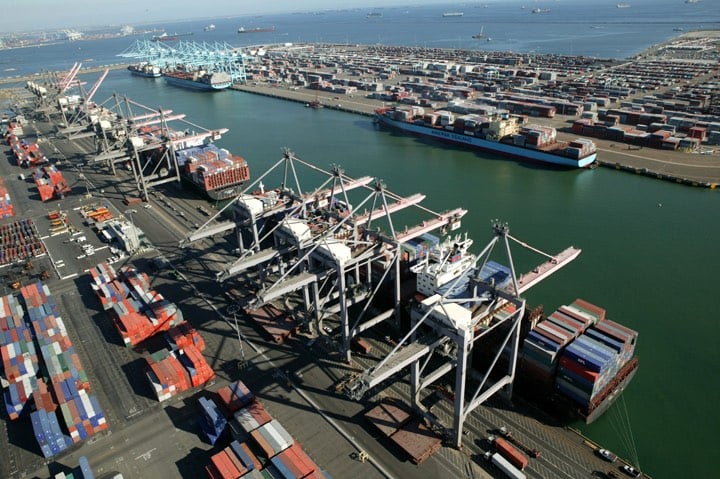It’s easy to get caught out by ocean container freight rate spikes when – on the face of it – they seem to defy market conditions, but you can find explanations and greater understanding through data analysis.
This is essential in protecting supply chains and managing freight spend.
A great example is taking place right now on the Transpacific trade from China to US West Coast. Average spot rates on this trade peaked at USD 5 553 per FEU (40ft container) on 5 June before plummeting 68% to USD 1779 per FEU by 31 August.
With the frontloading seen earlier in the year easing, you could be forgiven for expecting further declines during September. Instead, average spot rates have increased 36% to reach USD 2421 on 17 September.
There doesn’t seem to be an obvious explanation for this spike… until you use data to understand the various sub-plots playing out on the global stage.

Understand relationships between trades
One hypothesis is that spot rates dropped “too low” on the Transpacific at the end of August and the spike during September is the market correcting itself. This is supported when you look at the Transpacific trade’s relationship with other major fronthauls.
For example, on 31 December 2023, just as the Red Sea crisis was escalating, average spot rates on the trades from China to US West Coast and North Europe were almost at parity (USD 1782 per FEU and USD 1753 per FEU respectively).
As recently as 30 June 2025, spot rates on these trades once again came close to parity, with China to US West Coast slightly higher than North Europe at USD 3097 per FEU and into USD 2852 per FEU.
From that point, spot rates on these trades diverged, with North Europe becoming increasingly more expensive than US West Coast. By August 31, the spread between these trades was USD 800 per FEU. Importantly, this increasing spread was due to spot rates falling 43% into the US West Coast (USD 1779 per FEU) while North Europe fell by a much lesser 10% (USD 2578 per FEU).

When viewed in the context of its relationship with the trade to North Europe and spread of 800 per FEU, you could argue the trade to US West Coast had fallen “too low” on 31 August. If so, the spread between these trades should narrow during September – and that is exactly what is happening, with spot rates increasing 36% into the US West Coast and falling 24% into North Europe.
The spread is now a more ‘recognizable’ USD 454 per FEU and could close further in the coming days.
Far from being a surprise, the uptick on the Transpacific could simply be a “correction”.
In the long term, the relationships between trades should be relatively stable because carriers will move capacity in response to market conditions.
There are many sub-plots to consider
Global supply chains are highly complex, so it would be a mistake to oversimplify developments in freight rates. While the above data provides one explanation for the uptick on the Transpacific, there are other sub-plots to consider.
For example, Golden Week at the start of October means many shippers will be trying to export as many goods as possible out of China before factories shut down for the national holiday period. This increasing demand could put upward pressure on rates.
There is also the upcoming USTR port fees coming into force in October to consider, with China-built ships and China operators facing an additional levy when importing goods into the US.
Carriers are already swapping out China-built vessels on services to reduce exposure to the USTR fees. For example, Gemini shipping alliance is swapping out a total of 60 000 TEU across six China-built vessels on the US2 service, which calls at both the US East Coast and US West Coast.
Swapping out China-built vessels may not result in lower capacity or blanked sailings, but it will cause disruption and could contribute to the freight rate spike on the Transpacific.
Data can bring calmness and clarity
If you are a shipper on the Transpacific trade and you see an unexpected spot rate spike of 36% during September, it is easy to be spooked.
We see time and again how market sentiment can impact freight rates, with nervous shippers feeling compelled to pay higher prices to move their containers. This vicious circle then sees freight rates spiral when the underlying dynamics of demand and supply suggests it should not be happening.
On the other hand, those shippers who have data and market intelligence gain greater clarity on why freight rates are behaving in a certain way. While a shipper may not be happy about increasing freight rates, understanding why it is happening and how the markets are likely to develop allows them to remain calm and make the right financial and operational decisions.
Power of data during tenders
This level of data and intelligence will be particularly important ahead of tendering for new long term ocean container contracts in 2026. While freight rates have been trending downward since June on the Transpacific, they are still volatile, as we have seen with the September uptick.
If there is a similar uptick during a tender period, the carrier can use it to their advantage to argue for a higher long term contract rate.
However, if a shipper has data and market intelligence, they can push back by explaining why rates are behaving in a certain way and where they are likely headed during the contract term. This is an incredibly powerful negotiating tool.
%201.png)




.png?width=387&name=image%20(45).png)

